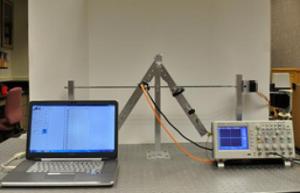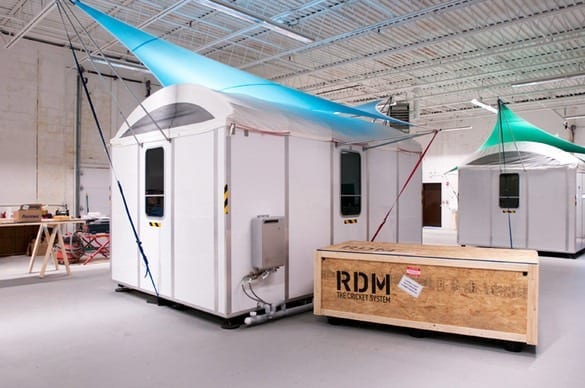Everyone might want super fast trains or driverless cars, but the real innovations in transportation are going to involve infrastructure. Meet the road of the future
This week the San Francisco-Oakland Bay Bridge was lit in the greatest LED art display ever. I was dazzled, but a little side-note in the news story caught my attention. The Bay Bridge opened in 1936, after construction began in 1933. The grandness of this bridge was quickly eclipsed, however, when the more picturesque Golden Gate Bridge opened in 1937. Its construction too had begun in 1933.
I had to look at those construction dates once more. This was the depth of the Great Depression. Today, in our own economic doldrums, it is hard to conceive of such projects. I begin with these examples because the first reaction to what I am about to tell you about future transportation infrastructure is very likely to be, “Nope, we can’t afford that, never gonna happen.” Just keep in mind an earlier generation of leaders and citizens looked hardship in the eye and proceeded to build a new future. I think it is past time to do that again.
When we contemplate the future of transportation we think of bullet trains, electric autonomous cars, sub-orbital planes and the like. We even wonder–still–when the flying car will land in reality. But we don’t think much about the infrastructure on which those vehicles depend. Some very enterprising and creative engineers do, however. Here are two ideas for re-inventing the road that I think could, literally, change everything about future transportation, if we care to be as bold as our ancestors in the 1930s.
First up is Solar Roadways. What is a road? A strip of asphalt, concrete, dirt, or cobblestone on which wheeled vehicles roll. Road materials have advanced since Roman days, but not all that much, really. It is still just a hard surface, designed to support the weight of vehicles and keep us out of the mud. Twenty four hours a day, roads, parking lots, and sidewalks just sit there, and in the day time they mostly just sit there collecting heat and light but not doing anything with it.
Imagine, as Solar Roadways has, that you could replace the concrete or asphalt with solar cells beneath a layer of glass. Operating at 15% efficiency the U.S. road system would provide more than four times our current electricity needs, or about as much electricity as the whole world uses. It’s a lot of potential power.
It turns out it is not that hard to take “off the shelf” material and build a layer of solar cells between sealed layers of glass, and construct a roadway surface of the resulting panels. The primary complication is manufacturing glass that is strong enough for an 18-wheeler to drive on, that is clear enough to allow sunlight in but opaque enough not to emit too much glare, with sufficient traction and durable enough to last for years. The glass design challenge is one that Solar Roadways is working on, among others, and one they plan to test with their first road panels installed in a parking lot in the spring of 2013.
The Latest Bing News on:
Future Of Transportation
- The future of transportation: Clinton brings first electric bike shop to the Mohawk Valleyon April 26, 2024 at 10:39 am
What sets apart the new e-bike shop in Clinton from others? Bill Khlem, chief executive of eBliss, claims its the innovation.
- Ansh Pyura Verma (Anshuman Verma): Pioneering the Future of Transportation with Innovative Vehicle Technologieson April 26, 2024 at 12:42 am
Verma’s journey into the realm of transportation began with a keen interest in solving real-world problems through innovative design.
- The future of transportation is being transformedon April 26, 2024 at 12:39 am
The global transportation industry, while still expanding, faces a slowdown attributed to various factors, notably the enduring impacts of the pandemic. Despite this, projections anticipate ...
- Cecil College Offers Students the Chance to Shape the Future of Transportation with Eisenhower Fellowshipon April 25, 2024 at 9:00 am
Cecil College has announced an opportunity for students with a vision for the future of transportation to step forward and make their mark. The college is currently accepting applications for the 2024 ...
- Expansion, innovation of Central Florida's highways crucial for Orlando's transportation puzzleon April 25, 2024 at 5:30 am
"Roads and highways are definitely a vital component of our transportation puzzle." Here's more on the what the future of highways looks like in Central Florida.
- The Evolution of Connected Cars: How 5G Shapes the Future of Transportationon April 23, 2024 at 10:22 am
The way we travel is just one of the numerous ways technology transforms our hectic, fast-paced lives. The most notable development of late has been the ...
- New report looks at the future of transportation in Mass., defines WMass residents' prioritieson April 18, 2024 at 7:37 am
MassDOT has drafted a vision of what the future of transportation may look like in the state in 2050. A key architect in this process is Derek Krevat. He's the project manager for this statewide ...
- New report looks at the future of transportation in Mass., defines WMass residents' prioritieson April 18, 2024 at 7:37 am
Beyond Mobility is a Massachusetts Department of Transportation document the state and agencies will use for the next 25 years to build-out and maintain the transportation infrastructure in ...
- Revolutionizing the Future of Transportation with Autonomous Drivingon April 16, 2024 at 3:20 am
The future of transportation with autonomous driving shows great promise. We anticipate safer roads, reduced congestion, and enhanced mobility for all. By tackling the associated challenges and ...
- Orange County commissioner to hold community meeting about future of transportationon March 31, 2024 at 1:41 pm
Orange County District 6 Commissioner Michael Scott will be hosting a community meeting on transportation. According to the county, it will be a "candid discussion about the future of ...
The Latest Google Headlines on:
Future Of Transportation
[google_news title=”” keyword=”Future Of Transportation” num_posts=”10″ blurb_length=”0″ show_thumb=”left”] [/vc_column_text]The Latest Bing News on:
Solar Roadways
- County board to discuss Skeleton Creek solar projecton April 26, 2024 at 9:00 pm
Commissioners will meet at 9 a.m. Monday in the courthouse to review plans from NextEra Energy, developer of the large project, to be located in a rural area south of ...
- Public hearing planned in Canton for Rich Road solar siteon April 26, 2024 at 2:05 pm
The EDF Renewables 240-megawatt Rich Road solar project with 20-megawatt battery energy storage system continues its path toward reality following the recent issuance of a draft permit ...
- Report on solar farm says 'inability to establish' criteria before Monday's public hearingon April 26, 2024 at 2:24 am
Staff of several state agencies have recommended that the Ohio Power Siting Board deny the application for a proposed solar farm in Marion County.
- Minnesota will soon be home to 5th largest solar facility in the nationon April 25, 2024 at 8:30 pm
Xcel's Sherco solar facility is the largest solar project in the state of Minnesota, and by the time it's done in 2026, it'll be the fifth-largest solar facility in the country.
- My Turn: Industrial solar installations are overwhelming Northfield neighborhoodon April 25, 2024 at 1:26 pm
Twenty-six thousand panels were recently approved on Pine Meadow Road in Northfield and are scheduled to be installed in our residential/agricultural-zoned neighborhood. It was appealed and argued ...
- Abbey's Road: Witnessing history with loved ones during a once-in-a-lifetime solar eclipseon April 14, 2024 at 3:04 am
Abbey and her family gather to celebrate the April 8, 2024, solar eclipse in Ohio and spend needed family time together.
- ISP bolstering its presence to make roadways safe during solar eclipse celebrationon March 29, 2024 at 3:54 pm
YOU CAN PLAN AHEAD BEFORE GETTING ON THE ROAD. WHILE EYES MIGHT BE DRAWN TO THE SKIES DURING THE TOTAL SOLAR ECLIPSE, LAW ENFORCEMENT IS WARNING DRIVERS TO KEEP THAT SAME FOCUS AFTER TOTALITY.
- For solar eclipse safety, here's what drivers should not do on the road during the rare eventon March 28, 2024 at 3:46 am
FOR SOLAR ECLIPSE ON APRIL 8 ... are advised to take caution if they attempt to view it while they're on the road. Dr. Bill Blair, an astrophysicist at Johns Hopkins University in Maryland ...
- For solar eclipse safety, here's what drivers should not do on the road during the rare eventon March 28, 2024 at 3:00 am
The sun, the moon and the Earth will all align in a North American solar eclipse on Monday, April 8. Millions of Americans from Texas to Maine, who are in the path of totality, will be able to ...
- Earth Talk: Solar roadwayson January 9, 2024 at 1:19 am
Solar roadways are also incredibly expensive compared to regular old pavement. While Solar Roadways has not implemented the concept as of yet in the U.S., there have been a few projects abroad ...
The Latest Google Headlines on:
Solar Roadways
[google_news title=”” keyword=”Solar Roadways” num_posts=”10″ blurb_length=”0″ show_thumb=”left”]










